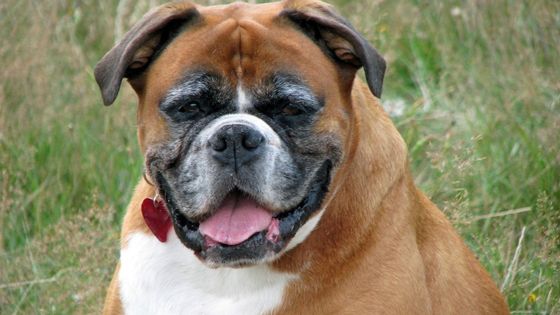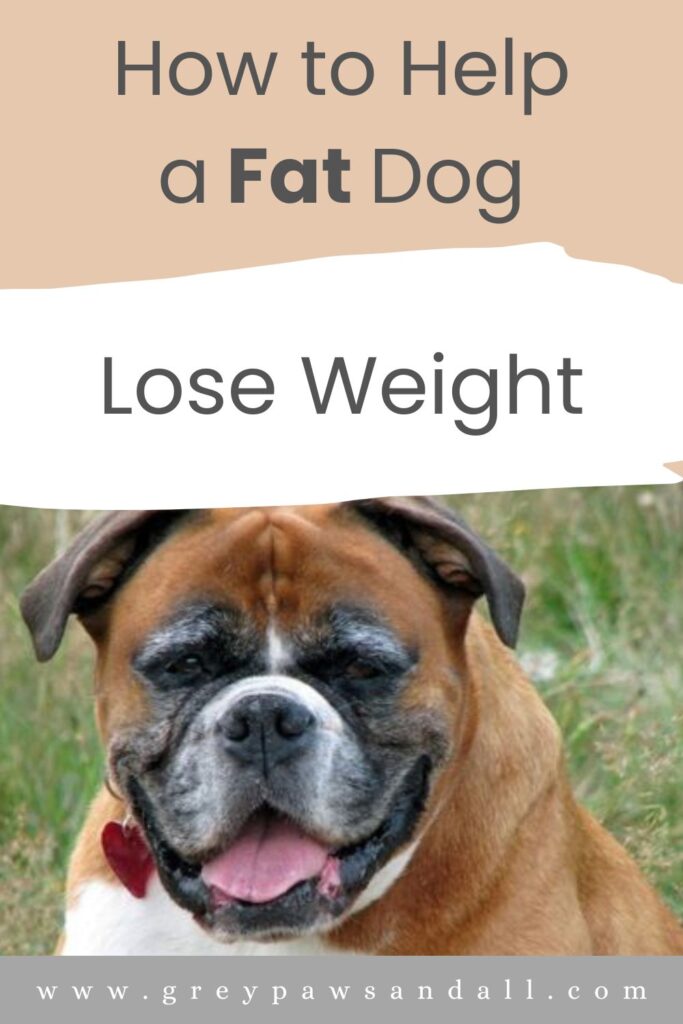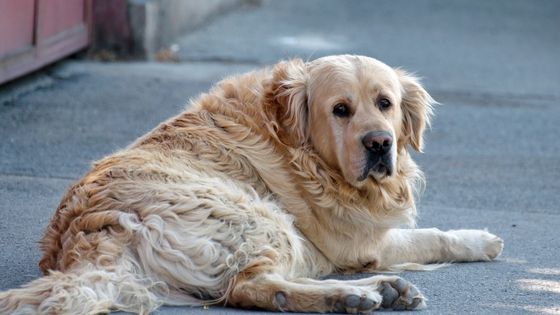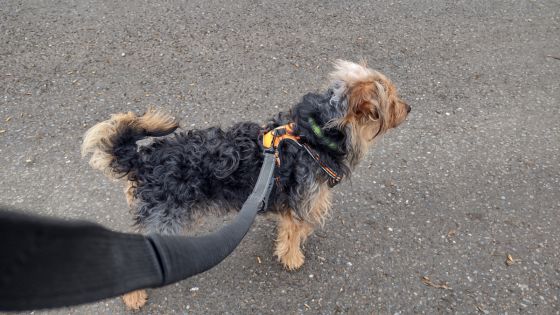Isn’t it heart breaking watching a fat dog barely able to walk, panting with each step he tries to take.
If you have a dog that needs to lose weight, the first step is to make an appointment with your vet. He will weigh your dog, discuss a new diet or adjustment to his current one, and recommend an exercise plan you will need to follow.
*There are affiliate links in this post, which means if you buy something I may receive a commission. This has no effect on the price you pay.*
Sobering Statistics About Dog Obesity
This quote is from the Association for Pet Obesity Prevention website, summarizing their 2021 survey results: “Only 39% of dog owners and 45% of cat owners consider their pet overweight or having obesity. This contrasts with numerous reports indicating over 50% of dogs and cats are overweight or have obesity.”
To read the survey results, click here.
♦ Here are some of the results from the 2018 survey:
- 55.8% of dogs are classed as overweight or obese, which is an estimated 50 million dogs
- Pet owners and veterinary professionals were confused by conflicting pet nutritional advice and continue to struggle to help pets achieve safe and ideal weights.
- 80% of vets said they had tried to help their pet lose weight
- 68% of pet owners said they had tried to help their pet lose weight
- 38% of pet owners said their vet made a recommendation about the best diet
- 22% said they “had to ask” their vet about an appropriate diet
- 40% replied they received no dietary advice from their vet
♦ According to the UK Pet Food Manufacturers’ Association (PFMA) 2019 pet obesity report:
- 74% of vets believe pet obesity has increased over the last five years
- 51% of dogs are obese
- 100% of vets were concerned about the prevalence of obesity
- 73% stated it was ‘one of the most prevalent conditions seen
- 67% of “owners” are not concerned about obesity
How To Tell If Your Dog is Too Fat
According to hillspet.com “you should be able to feel all of your dog’s ribs without a thick layer of fat over them. Your dog’s chest should also be wider than his abdomen, with a noticeable tuck-up from chest to stomach. An overweight dog will generally have no waist and no distinction between chest and stomach.” .
Knowing your dog’s ideal weight makes it easier for you to maintain it. Whenever I take my dogs to the vet, no matter the reason, they are always weighed. The information creates a graph, making it easy for the vet to tell if their weight is where it should be, and if there’s been weight loss it could indicate a problem. I’m also good at eyeballing it and am mindful about what I feed them.
Dog Weight Chart By Breed
The American Kennel Club website has quite a lengthy list of breeds and their ideal weight. In the table below you will find a few for easy reference, and to view the entire list click here.
| Breed | Weight for male | Weight for female |
| Border Collies | 30-55 pounds | 30-55 pounds |
| Chihuahuas | no more than 6 pounds | no more than 6 pounds |
| Dachshunds (standard) | 16-32 pounds | 16-32 pounds |
| German Shepherds | 65-90 pounds | 50-70 pounds |
| Pugs | 14-18 pounds | 14-18 pounds |
| Retrievers (Labrador) | 65-80 pounds | 55-70 pounds |
| Shih Tzu | 9-16 pounds | 9-16 pounds |
| West Highland Terriers (Westies) | 15-20 pounds | 15-20 pounds |
| Yorkshire Terriers (Yorkies) | 7 pounds | 7 pounds |
This doesn’t take into account mixed breeds or “mutts” as we fondly call them. For example, one of my dogs was a Chihuahua/Min Pin so the guide for chihuahua would not be accurate. I also have a Maltese mix of some sort and if he was under 7lbs he would be underweight. Your vet will help you figure it out.

Why Dogs Get Fat
Lack of exercise – many dogs don’t get nearly the amount of exercise they need to stay healthy so weight gain, boredom and behavior issues are the result.
Too lazy to move – I can’t count the number of times I’ve heard people say their dogs are lazy, and that’s the reason they don’t go for walks and are fat. While it’s true not all dogs are high energy, not being walked from the time they were puppies can make some too lazy to want to move.
What some call lazy could actually be depression from being stuck in the house, or going no further than the backyard to pee and poop.
Pain – if a dog is in pain, whether it’s joint pain or some other condition, he will not feel up to walking.
Too many treats – There’s nothing wrong with treats, it’s the amount and type that become an issue when it causes weight gain.
I know your dog is adorable, but rather than constantly feeding him to show your love, a game of fetch or walk in the park is a much better way to show you care.
Many store bought treats are nothing more than junk food, and cause weight gain while providing no nutritional value to your dog. Read labels, buy single or minimal ingredient products, use boiled chicken or dog safe vegetables instead. Check Pinterest for hundreds of easy to make healthy treats.
Feeding table scraps – There are several reasons why feeding table scraps is a bad idea.
- Causes weight gain
- High fat foods could lead to pancreatitis, a painful and sometimes deadly condition
- Encourages bad behavior by rewarding your dog for barking. One day you may have been eating, your dog started barking, it drove you crazy, you wanted to eat in peace so you gave him food to keep him quiet. He quickly learned barking got him delicious food from the table.
Health conditions – Hypothyroidism and Cushing’s can explain weight gain, which is why a health check is important to determine whether or not an underlying condition is responsible.
Are Fat Dogs Healthy?
Just like overweight people are more prone to serious health consequences, the same holds true for dogs. So no, fat dogs are not healthy.

Long Term Health Effects for Obese Dogs
- Added stress on bones and joints makes arthritis worse
- Heart disease
- High blood pressure
- Panting and difficulty breathing in warmer weather
- Cancer – National Canine Cancer Foundation mentions.
- Diabetes
- Pancreatitis as I mentioned above due to eating fatty foods
- Shorter life span
To read more about dog obesity and cancer – “Researchers explore impact of obesity on dog’s health”
How Long Can an Overweight Dog Live?
It’s impossible to say how long any dog will live, let alone an overweight one. There are rough ideas about life expectancy for various breeds, but with all the mixes out there who can really say. Add to that the potential health complications that can arise due to extra weight and it’s anybody’s guess. It would be safe to assume an overweight dog’s lifespan will be shorter than a healthy dog at a healthy weight.
Based on your dog’s current health status your vet may be able to offer some insight, but that is in no way a prediction.
To help your dog live a long, healthy and happy life he needs:
- A nutritious diet
- To be at a healthy weight
- Plenty of physical exercise and mental stimulation
- A kind and loving home
Dog Breeds Prone to Obesity
I did some research into whether specific breeds are more prone to it, and this is what I found.
- Basset Hounds
- Beagles
- Bernese Mountain Dogs
- Bulldogs – no surprise
- Cairn Terriers
- Cocker Spaniels
- Dachshunds
- Labs
- Newfoundlands (Newfies)
- Pugs – no surprise there, a large percentage of pugs I see are fat
- Retrievers
- Rottweilers
- Saint Bernards
- Scottish Terriers
- Shetland Sheepdogs
- West Highland Terriers (Westies)
My goodness, it seems like an awful lot of breeds are prone to getting fat! I’m not a vet, but I believe all dogs can become obese if they’re overfed and under exercised.
Where do mutts come in then? Whether your dog is on this list or not, a well balanced healthy diet, quality treats given sparingly and an active lifestyle (appropriate for his ability) should keep your dog at a healthy weight. Obviously it’s a different story if medical issues are present.
Do Dogs Put on Weight as They Get Older?
Not every old dog will put on weight, in fact you’ll find many old dogs lose weight. As dogs age, medical conditions such as arthritis for example, can make walking more painful so walks aren’t as long as they used to be. Combine that with eating the same amount of food as when they were more active, and it’s no surprise if they put on some weight. Once the issue is managed, your dog may feel well enough to start exercising again but your vet will advise you on what’s appropriate. There are some ideas below that may help.
Another point I’d like to mention is this. I often hear senior dog parents say their dogs are perfectly happy lying in their bed all day. That can absolutely be the case, but it can also be a catch 22. They don’t take them out because they don’t think they want to go out so the dog is bored and just sleeps, confirming what the dog owner thought in the first place!
How Long Does it Take For a Dog to Lose Weight?
According to VCA hospitals, a loss of 1-5 pounds a month is a healthy rate, and most dogs can be expected to reach their target weight in 6-8 months. Obviously if a dog only needs to lose a pound or two it won’t take that long. Some dogs will lose weight quicker than others, and commitment of the pet parent to the weight loss journey is key.

How to Help a Dog Lose Weight
It’s a family matter
Everyone who lives in your household must be on board and follow the rules of the plan. You cannot have one person sneaking him treats or giving him extra food because they think he’s hungry. It’s important they understand the seriousness of your dog’s condition, and what diseases he is at risk of developing.
Diet
- Your vet will need to know your dog’s current diet:
- What type of food he’s eating
- How many meals a day
- How much in total or per meal (exact amount would be helpful)
- What type of treats
- How many
- How often
- Are you feeding table scraps
- How often
- What type
Depending on your vet, he or she may:
- Prescribe a diet dog food
- Suggest a better quality brand than what you’re feeding at the moment
- Adjust the amount your dog is currently eating
- Recommend a home cooked diet
- As far as treats go, your vet may recommend:
- Reducing the amount of treats you give your dog
- Switching to a brand with less fat
- Suggest you make your own healthy version
- Use vegetables
Ask your vet or weight loss clinic nurse for a list of human foods you can add to his diet in case he’s not happy with it. Also ask what they think of dividing the daily allowance into 3 meals instead of 2, if you think your dog is always looking for food.
Exercise
Your vet or weight loss clinic staff should provide you with an exercise plan that will not only be safe but effective. There are lots of ways to get your overweight dog moving, and they are listed below.
Read this ⇒ 18 Ways to Exercise a Dog Indoors
NOTE: Before trying any form of exercise that is not included in your plan, please consult with your vet practice. They will advise you on how often it’s safe and for how long.
Go for a walk – This is the most basic form of exercise every dog needs, yet many sadly don’t get. At the beginning of your dog’s weight loss journey he probably won’t be able to walk far or for long, but as his weight starts to drop walks will become more enjoyable. Don’t underestimate how much better he’ll feel even after losing a few ounces.
If your dog has been uninterested in walking, perhaps a change of scenery will help. Take him to a park he’s never been to, or walk down a different street. New sights and sounds may be all the motivation he needs.
Swimming – low impact and easy on the joints, swimming is a great form of exercise. Use your own backyard pool, pay a visit to a lake that allows dogs, find a dog friendly pool or dog hydrotherapy facility in your area.
Doga – enthusiasts of doga, also known as yoga with your dog believe it offers many benefits.
- Creates a deeper bond between person and pup
- Helps relax dogs
- Lose fat
- Build muscle
- Helps with blood circulation
- Presents an opportunity for both of you to socialize
Fetch – a fabulous way for dogs to burn off energy, especially those who have an abundance of it and a simple walk isn’t enough. In your dog’s case, you’ll need a calmer and less energetic version to start with.
Agility training – an organized class will probably be too much for your dog at this stage, but what about setting up your own agility course? It’s super easy to do at home or in the yard, and it doesn’t have to cost a lot either. Make sure the height of various equipment and the length of time he spends going through the course are approved by whoever is overseeing his weight loss program.
“Create a Dog Agility Obstacle Course at Home”
Monitor Your Dog’s Activity Level

One way to keep track of your dog’s activity level is to simply write down what exercise you did and how long your dog did it for.
What Is the Best Dog Food for Weight Loss?
I always say the world of dog nutrition is like a minefield, tough to navigate. While many vets, nutritionists and dog parents are sure that A is the absolute best diet, an equal number believe it’s B and others have no doubt it’s C.
When it comes to weight loss, one common theme I’ve heard is the importance of a high fiber diet because it will make your dog feel full while eating less. So why have I also read the complete opposite?
The best food is what will help your dog reach a normal, healthy weight, but there is no one size fits all weight loss strategy.
When I adopted my heart dog Red she was around eight years old, blind and obese. She was a Chihuahua/Min Pin and her stomach almost touched the ground. It was so sad, she couldn’t take more than one or two steps without sitting down and panting. We headed straight to the vet for help with weight loss. Hills brand r/d dry was recommended, and when she lost some weight she was switched over to w/d. It worked beautifully and she was a much happier and healthier dog. Once she was at her healthy weight, I switched to a better quality, limited ingredient wet food, and added other foods for interest which I rotated such as: boiled chicken breast, boiled white fish, quinoa, sweet potato, cooked green beans, cooked carrots, raw apple and some broccoli to name just a few.
If you will be switching food, your vet will advise you to allow about one week to make the transition. This is done by gradually adding the new food into his existing diet until he is only eating new food. This reduces the chance of stomach upset.
If you aren’t wild about the brand that was recommended, have a chat with your vet and voice your concerns. Since your dog’s weight needs to be addressed immediately, you can’t afford to wait too long before starting him on this journey.
What Happens If Your Dog Keeps Begging For Food?
- Take him for a walk
- Play fetch, set up a training session or take him to visit a doggy friend. It’s a distraction and a chance to get some more exercise in a fun way
- If his begging has gotten really bad, phone your vet’s office and let them know. The brand may not be satisfying so they could increase the amount, suggest you add human food, offer snacks like raw carrots or change to a different brand.
How to Feed a Fat Dog in a Multi Dog Household
The only way to manage this is to feed the dogs separately, and not leave food out where your chubby one can get to it.
Have you ever shared your life with an overweight dog? Do you have any advice or tips you used to help him or her lose weight? Sharing helps others, so leave them in the comments below.
How have you helped your dog slim down? Sharing helps others so please leave your tips in the comments section below. They could really make a difference in a dog’s health and wellbeing.
I help senior dog parents struggling with anticipatory grief and quality of life issues by offering practical tips, advice and one on one support. I am also a Certified Pet Loss Grief Support Coach, helping you navigate through your pet loss journey.
Visit my services page to book a FREE 20 minute discovery call, or email me (Hindy) at hpearson141@gmail.com if you have any questions.
I’ve been rescuing and caring for senior dogs since 2009. From vision and hearing loss to obesity, dementia, kidney disease, liver issues, cardiac problems, Cushing’s, mobility challenges and more, you could say I’ve dealt with and learned a lot! In addition to my hands on experience, I’ve taken many courses and earned several qualifications to keep learning how to help senior dogs and they include: Senior Dog Enrichment, Understanding Canine Anxiety, Care of the Senior Pet and I’m a Certified Pet Loss Specialist.

I couldn’t agree with you more about how sad it is to see an overweight dog. We are their caretakers. That means if they aren’t in good condition (given things we can control) then we are failing them. It’s not a big ask to exercise your pup and feed them properly. That seems like the bare minimum. Super good article! Love the idea of your health and wellness service. I’m certain it will help a lot of dog parents. I’m sharing with all my dog parents.
Thanks Terri! When I first met Red she was around 8, blind, eyes bulging out of her head because of glaucoma and weighed 18 lbs when she shouldn’t have weighed more than 10 lbs. She was so fat she couldn’t take more than one or two steps before she had to sit. How someone let her get like that was so sad. Luckily it didn’t take too long to lose the weight and not only was she healthier she was happier.
Great post and it kills me to see obese dogs and when you talk to a dog parent about it they will come up with a million answers why their dog is not obese. I watched Layla’s weight from the day I rescued her and thank goodness she never was over weight. It is like humans, they get ill from obesity and it needs to be monitored.
A dog’s weight is super important to their health. My dogs have all been at optimal weight – if only I could keep myself at such a good weight LOL! Our Veterinarians always comment on their weight being “optimal”. Weight tells you so much about their health, that’s why the Vet will weight your pet every time they walk through the door.
We have one pup who we have to monitor her weight constantly. She has arthritis and other issues so keeping her weight down is important. She loves to eat more than anything so it’s a challenge! We traded treats for carrots and other veggie treats.
Such an important post and you give such great tips and information. I was fortunate in that my Huskies were all fit, the only time I had an issue with one being overweight was my beautiful boy Gibson after he went on anti-seizure medications. He gained 20 lbs! But with diet (pumpkin and pureed green beans helped a lot!) and exercise, I was able t get him back down to his normal weight. I always shudder when I see overweight dogs, this will be a great help!
PS – Congrats on your new support service, Hindy!
Gibson must have felt so much better once he was able to shed that excess weight. Lucky he had such a great dog mom! It makes me so sad when I see what people have done to their dogs, it’s abuse as far as I’m concerned. Thanks, I’m excited about the support service, it’s another resource I can offer.